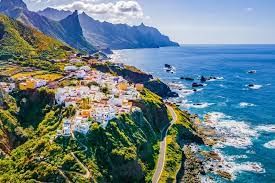UPSC Daily Current Affairs- 23rd June 2023 | Current Affairs & Hindu Analysis: Daily, Weekly & Monthly PDF Download
| Table of contents |

|
| GS-I |

|
| About Canary Island: |

|
| GS-II |

|
| About Global Gender Gap Index: |

|
| GS-III |

|
| About Sarmat Missile: |

|
GS-I
Discovery of Ancient Maya City
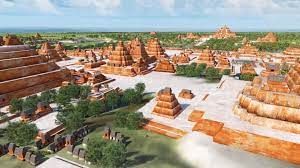
Why in News?
Archaeologists in Mexico have made a significant discovery in the dense jungle of the Yucatan Peninsula, uncovering the remains of an ancient Maya city.
What are the Major Findings Related to Ancient Maya City?
- About:
- The National Institute for Anthropology and History (INAH) in Mexico led the expedition to Ocomtún.
- The research team used airborne laser scanning to identify pre-Hispanic structures throughout the region.
- Named Ocomtun, meaning "stone column" in the Yucatec Maya language, this newly discovered city is believed to have been a prominent centre in the central lowland region of the Yucatan Peninsula between 250 and 1000 AD.
- It also provides invaluable insights into the advanced societal and religious practices of the Maya civilization, known for its sophisticated mathematical calendars.
- Major Findings:
- Elevated Terrain: One of the most surprising findings was an elevated terrain surrounded by wetlands, suggesting a unique and strategic settlement pattern.
- Pottery: Pottery fragments found at the site indicate that Ocomtún was inhabited during the Late Classic period (600-900 A.D.)
- Central Altars: It was discovered near the La Riguena river, possibly used for community rituals.
- Central altars suggest the presence of community rituals, highlighting the spiritual and communal aspects of Maya life.
- Pre-Hispanic Ball Games: It was played throughout the Maya region, representing a religious practice.
- The game involved passing a rubber ball, symbolising the sun, through a stone hoop without using hands.
- Decline of the City: The site likely underwent significant changes between 800 and 1000 AD.
- This period coincided with the decline and collapse of the Lowland Maya civilization, which was marked by a decline in population, urban centres, and political instability.
- The fall of Ocomtún and other Maya cities was part of a larger regional collapse, signifying a transformative period in Maya history.
What are the Key Facts of Mexico?
- Form of Government: Republic of federated states
- Capital: Mexico City
- Official Language: Spanish
- Money: Peso
- Major Mountain Ranges: Sierra Madre
- Major Rivers: Rio Grande, Yaqui
Source: The Hindu
Canary Island
Why in News?
Recently, more than 30 migrants are feared dead after a small boat headed for Spain's Canary Islands sank.
About Canary Island:
- It is an archipelago located in the Atlantic Ocean
- It is about 1300 km South of mainland Spain and 115 km West of the African coast (Morocco).
- The Canaries comprise the Spanish provincias (provinces) of Las Palmas and Santa Cruz de Tenerife.
- These Islands were formed by volcanic eruptions millions of years ago.
- Climatic condition: They have a subtropical climate. Temperatures are warm and show little seasonal variation.
- It has rich volcanic soils and mild temperatures that support a wide variety of vegetation that generally follows a zonal arrangement based on elevation.
What is an archipelago?
- An archipelago is a term used to describe a group or chain of islands that are closely scattered in a body of water, such as a sea, ocean, lake, or river.
- These islands are typically formed through geological processes such as volcanic activity, tectonic movements, or the accumulation of sediment
Source: PIB
GS-II
Delhi Statehood
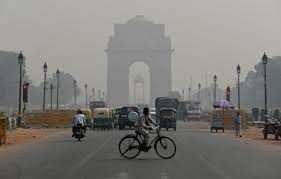
Why in News?
Recently, the debates about the conflict between the Union government and the Government of the National Capital Territory of Delhi (GNCTD) over the grant of Statehood to Delhi started again.
About Delhi Statehood:-
Background:
- There is an ongoing discussion regarding the conflict between the Union government and the Government of the National Capital Territory of Delhi (GNCTD) for the statehood grant to Delhi.
About Delhi Statehood:-
Historical Background:-
- After India attained independence on August 15, 1947, New Delhi was declared the capital of the Union of India.
- The Union Territory of Delhi was constituted from the Chief Commissioner’s Province of Delhi under the States Reorganization Act of 1956.
- The 69th Constitutional Amendment Act of 1991 conferred the UT of Delhi with a special status.
- It re-designated Delhi as the National Capital Territory of Delhi .
- It designated the administrator of Delhi (under Article 239) as the Lieutenant Governor (LG) of Delhi.
- These special provisions for Delhi were provided under Article 239AA.
- Article 239: Administration of Union territories.
Provisions under the Article 239AA
- It provides for a legislative assembly and a council of ministers for Delhi.
- Legislative assembly of Delhi is empowered to make laws on all the matters of the State List (except public order, police and land) and the Concurrent List.
- However, the laws of Parliament shall prevail over those made by the assembly in case of conflict.
- The Chief Minister of Delhi heads Council of Ministers of Delhi.
- It shall assists and advises the Lieutenant Governor (LG) in the exercise of his or her functions except in cases the LG has to act at his/her own
- If there is a difference of opinion between the ministers and the LG, the latter should refer the matter to the President of the country for a decision and act in accordance with that.
- The LG is also authorized to promulgate ordinances during the recess of the legislative assembly.
Issue of Statehood for Delhi
- Unlike the other Union Territories listed in Schedule 1 of the Constitution, Delhi has been given special status under Article 239 AA.
- However, there is an ever-going conflict with regard to the jurisdiction in the state due to which Delhi Government has been demanding a full statehood.
Need for statehood
Day-to-Day Problems
- The Delhi government lacks control over the transfers of officials, hindering their ability to manage the departments they were working in.
Frequent transfers:-
- Important officials are frequently transferred which minimizes the potential for effective governance.
Lack of Functional Control:–
- The elected government has no functional control over services.
- This results in challenges while punishing errant officers and addressing issues such as vacancies, vigilance enquiries, and corruption cases.
Conflicting Directives:–
- Officials are hesitant while following directives of the elected government due to being under the functional control of the LG.
- This creates confusion and hindered effective decision-making.
Lack of Answerability:
- The Services Department, under the control of the LG, have in the past refused to answer questions raised by Members of the Legislative Assembly (MLAs) in the Vidhan Sabha.
- This limits transparency and accountability, preventing MLAs from obtaining crucial information related to vacancies, corruption cases, and other issues.
Court’s Verdict and interpretations on the matter:-
- Supreme Court verdict, 2023: it stated that the government of Delhi possesses the authority to enact laws and oversee civil services in the national capital.
- The court restricted the jurisdiction of the Lieutenant Governor (LG) to bureaucrats in three distinct domains—public order, police, and land.
Source: Indian Express
China Blocks Proposal to Blacklist Pakistan-Based Terrorist
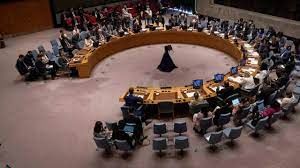
Why in News?
China's recent move to block a proposal at the United Nations (UN) to designate a Pakistan-based LeT terrorist as a global terrorist has drawn attention and raised concerns among the international community.
- In September 2022, China had put a hold on the proposal to designate the terrorist at the UN.
What is the Concern Raised Regarding China's Decision to Block the Proposal?
- The blocked proposal, brought forward by India and the United States, aimed to blacklist a wanted individual for his involvement in the 26/11 Mumbai terror attacks, under the 1267 Al Qaeda Sanctions Committee of the UN Security Council.
- This is not the first time China has blocked efforts to blacklist Pakistan-based terrorists under the UN Security Council's sanctions committee.
- China has consistently placed holds on listings that target individuals associated with terrorism in Pakistan including in 2009, 2016, 2017.
- China's actions have raised concerns among countries that seek to combat terrorism globally, as it appears to prioritise its relationship with Pakistan over international security cooperation.
- It also highlights the challenges of achieving consensus within the UN Security Council on sensitive issues related to terrorism.
What is the 1267 Al Qaeda Sanctions Committee?
- The committee is part of the UN Security Council and its job is to implement international sanctions against terrorists.
- The other two committees with similar roles are the Counter-Terrorism Committee and the Security Council Committee.
- The Al Qaeda committee was established as the Al-Qaida and Taliban Sanctions Committee on October 15, 1999, after Security Council Resolution 1267 designated al-Qaeda and the Taliban as terrorist bodies.
- In 2011, a separate committee was formed for the Taliban.
- Under the Committee regime, any UN member state can propose the name of an individual or group to be designated as a terrorist.
- Decisions are made by consensus in the 1267 Sanctions Committee, which comprises all members of the UNSC.
- A committee member can block blacklisting proposals by raising objections or applying a “technical hold” on a proposal.
- An individual or entity listed as a terrorist is subjected to an assets freeze, travel ban, and arms embargo.
Source: The Hindu
Global Gender Gap Index 2023
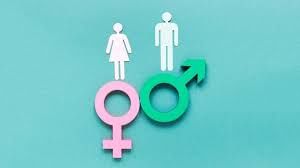
Why in News?
India was ranked at 127 out of 146 countries in terms of gender parity — an improvement of eight places from last year, according to the recently published annual Gender Gap Report, 2023.
About Global Gender Gap Index:
- Global Gender Gap Report is released annually by the World Economic Forum (WEF) since 2006.
- It measures gender parity in 146 countries and across four areas: economic participation and opportunity, educational attainment, health and survival and political empowerment.
- Highlights of Global Gender Gap Report 2023:
- India was ranked at 127 out of 146 countries in terms of gender parity, an improvement of eight places from last year.
- According to the report, India had attained parity in enrolment across all levels of education.
- India had closed 64.3% of the overall gender gap. However, it underlined that India had reached only 36.7 % parity on economic participation and opportunity.
- On political empowerment, India has registered 25.3% parity, with women representing 15.1% of parliamentarians — the highest for the country since the inaugural report in 2006.
- The index ranked India’s neighbours Pakistan at 142, Bangladesh at 59, China at 107, Nepal at 116, Sri Lanka at 115 and Bhutan at 103.
- Iceland is the most gender-equal country in the world for the 14th consecutive year and the only one to have closed more than 90% of its gender gap.
- Overall, the Southern Asian region has achieved 63.4% gender parity, the second-lowest of the eight regions.
Source: The Hindu
GS-III
Carbon Offsetting
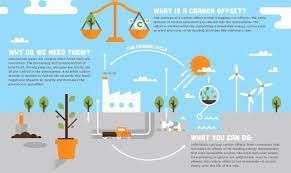
Why in News?
Delta Air Lines in 2020 marketed itself as the “world’s first carbon-neutral airline”, but recently California-based Mayanna Berrin filed a lawsuit against Delta arguing that the airlines’ assertions were bogus, misleading and false.
About Carbon Offsetting:
- It’s a slew of ways companies adopt to reduce or remove carbon emissions from the environment.
- Activities like planting trees, shifting to cleaner fuel and funding carbon capture techniques in theory balance out a company’s carbon emissions.
- Examples:
- Forestry: Tree planting projects restore areas facing deforestation. Trees absorb and hold carbon. Without them, that carbon would be in the atmosphere, making global warming worse.
- Agriculture: Farmers grow crops using technology and techniques to maximize resources and reduce waste when growing crops.
- Aviation: Airline operators optimize flight paths with AI to minimize the creation of contrail clouds.
- Renewable energy: These projects replace fossil fuel use with clean, renewable energy, such as that generated from a wind farm.
Positive Effects of Offsetting
- These programmes have the particular benefit of being a crucial step in resolving the CO2 issue and, when carried out properly, may provide noticeable improvements.
- Businesses may take action to offset their emissions and make significant strides toward sustainability rather than continuing to pollute.
- In locations where they are most needed, carbon offset programmes can directly contribute to programmes that benefit communities and the environment.
- They also offer the additional advantage of transferring financial resources from developed countries to underdeveloped ones in a market worth up to $120 billion.
- Funds for carbon offsets help developing nations create green infrastructure, make better use of their natural resources, and enhance the quality of their air, water, and land.
- Investing more money in green businesses may also provide economies of scale benefits, such as decreasing the price of solar and wind farms or creating innovative new technologies like direct air capture.
Problems with carbon offsets:
- In genuineness: Most of world’s carbon offsets certifier do not represent geniuses in carbon reductions.
- Lack of alternatives: Mostly planting trees are considered to reduce emissions and there are only few alternatives to reduce emissions.
- Same mechanisms for all companies: Planting trees or other alternatives cannot reduce emissions for all companies.
- Cheaper carbon credit: The expense of carbon credit are cheaper than reducing carbon emission so companies mostly prefer carbon credits.
- Regulation: Lack of regulation to carbon offsets industry.
- Lack of technology: In carbon technologies to capture carbon directly to offset carbon.
- Greenwashing: Most companies adhere to the greenwashing via avoidance offsets projects.
Govt. of India Initiatives:
- PAT (Perform, Achieve and Trade), a market-based scheme, has already prevented CO2 emissions of up to 92 million tonnes during its 1st and 2nd cycles.
- Indian Carbon Market (ICM): with an objective to decarbonize the Indian economy by pricing GHG emissions through trading of carbon credit certificates and in compliance with Article 6.2 of the Paris Agreement.
- Carbon Credit Trading Scheme that is expected to be notified in June 2023 with Carbon Credit Certificates under it are expected to be available for trading by 2025.
Way Forward:
There is an urgent need for companies and countries alike to identify high integrity projects that adhere to robust climate methodologies.
While an important tool, carbon offsetting cannot be considered a substitute for direct emissions reductions. Airlines should focus on decarbonising commercial aviation, with the help of sustainable aviation fuel (SAF), hydrogen, and full-electric propulsion techniques rather than making false claims.
Source: The Hindu
Sarmat Missile

Why in News?
Russian President recently said that, Russia's new generation of Sarmat intercontinental ballistic missiles, which are capable of carrying 10 or more nuclear warheads, would soon be deployed for combat duty.
About Sarmat Missile:
- The RS-28 Sarmat is Russia’s new generation intercontinental ballistic missiles.
- It is named after the Sarmatian people of the fourth and fifth century BC. It has also been referred to in the West as the "Satan II".
- It is capable of carrying 10 or more nuclear warheads.
- It is designed and built by the Makeyev Rocket Design Bureau, Russia.
- Features:
- It has a range of about 18,000 kilometres.
- It can travel at a maximum speed of 25,500kph.
- Propulsion: Three-stage, liquid-fueled
- Launch weight: 208,100 kg
- It can carry a 10 ton payload and can load a wide variety of warhead options.
- Sarmat can reportedly load up to 10 large warheads, 16 smaller ones, a combination of warheads and countermeasures, or hypersonic boost-glide vehicles
- While the RS-28 Sarmat can be launched much like a regular ICBM, it is thought to be also capable of what is called fractional orbital bombardment.
- A fractional orbital bombardment means firing an ICBM into a low orbit of the Earth – much lower than a conventional firing – potentially in the opposite direction to the target.
Source: PIB
|
38 videos|5258 docs|1111 tests
|

